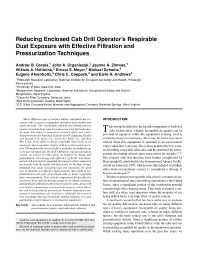Mining Publication: Reducing Enclosed Cab Drill Operator's Respirable Dust Exposure with Effective Filtration and Pressurization Techniques
Original creation date: January 2005
Many different types of surface mining equipment use enclosed cabs to protect equipment operators from health and safety hazards. The overburden removal and mining process can be extremely dusty and can cause excessive dust exposure. To study this issue, a cooperative research effort was established between the National Institute for Occupational Safety and Health, U.S. Silica Co., Clean Air Filter Co., and Red Dot Corp. in an effort to lower respirable dust levels in an enclosed cab on an older surface drill at a silica sand operation. Throughout this research effort, a number of modifications were incorporated into the drill's filtration and pressurization system, as well as in other areas, to improve its design and performance. An average cab efficiency of 93.4% was determined with the gravimetric sampling instruments when comparing the outside with the inside cab dust levels on the final design. Although this study considered just one operation, the goal was to identify cost-effective improvements that could be implemented on all types of enclosed cabs to lower respirable dust concentrations. Two critical components for an effective enclosed cab system are having a properly designed, installed, and maintained filtration and pressurization system, along with a method for maintaining structural cab integrity, which allows the cab to be positively pressurized. Another important component is maintaining cab cleanliness. Although this research was originally directed toward the mining industry, it is also applicable to agricultural or construction equipment.
Authors: AB Cecala, JA Organiscak, JA Zimmer, WA Heitbrink, ES Moyer, M Schmitz, E Ahrenholtz, CC Coppock, EH Andrews
Peer Reviewed Journal Article - January 2005
NIOSHTIC2 Number: 20025912
J Occup Environ Hyg 2005 Jan; 2(1):54-63
See Also
- Best Practices for Controlling Respirable Dust in Coal Mines
- Closing the Door to Dust When Adding Drill Steels: Uni-directional Cab Filtration and Pressurization System Tested
- Coal Workers’ Health Surveillance Program (CWHSP)
- The Effects of Low Quartz Mass Loading and Spatial Variability on the Quartz Analysis of Surface Coal Mine Dust Samples
- An Expanded Model for Predicting Surface Coal Mine Drill Respirable Dust Emissions
- Field Assessment of Control Techniques and Long-Term Dust Variability for Surface Coal Mine Rock Drills and Bulldozers
- Field Evaluation of Air-blocking Shelf for Dust Control on Blasthole Drills
- Improved Drill Shroud Capture of Respirable Dust Utilizing Air Nozzles Underneath the Drill Deck
- Optimizing Secondary Roof Support with the NIOSH Support Technology Optimization Program (STOP)
- Reducing Enclosed Cab Drill Operator's Respirable Dust Exposure at Surface Coal Operation With a Retrofitted Filtration and Pressurization System
- Content source: National Institute for Occupational Safety and Health, Mining Program


 ShareCompartir
ShareCompartir
